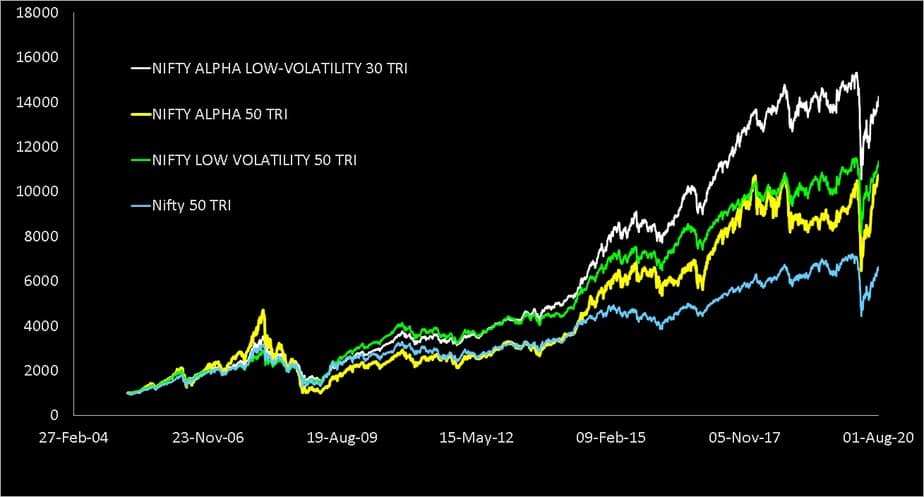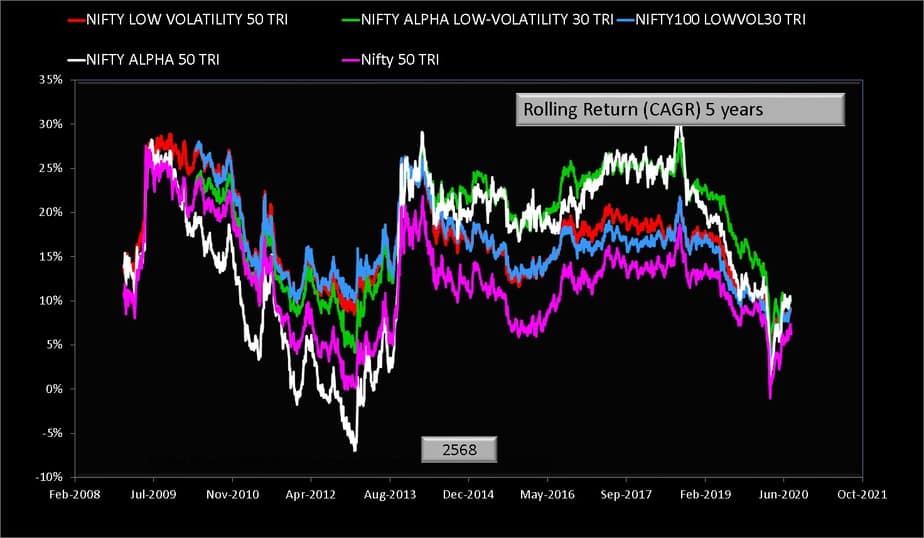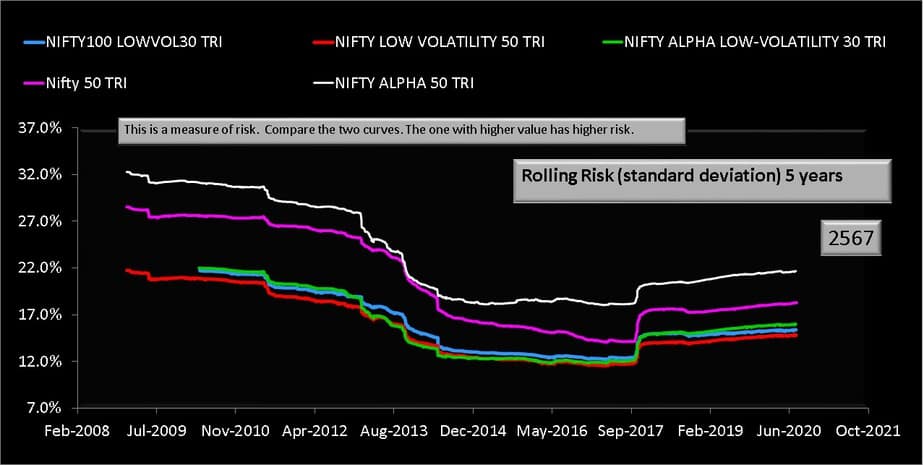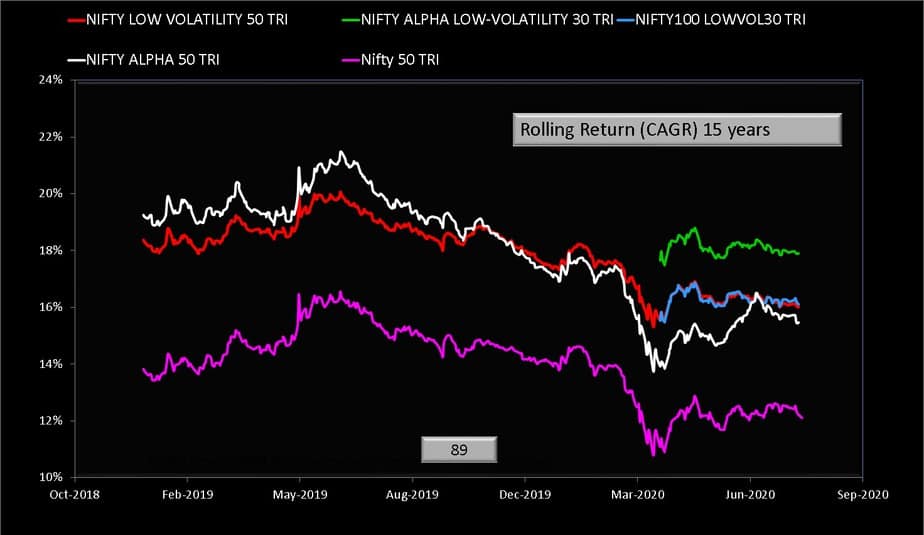Last Updated on April 29, 2025 at 10:18 am
ICICI Prudential Alpha Low Vol 30 ETF currently in its NFO period (Aug 3 to Aug 10) will be the first: “multi-factor” ETF in India. When investors hear the word “alpha” it starts all kinds of bells and whistles inside them. This is because of an incorrect understanding of what alpha actually is. Here is why one should get too excited over this ETF.
What is ICICI Prudential Alpha Low Vol 30 ETF: It is a two-factor exchange-traded fund that aims to provide returns closely corresponding to the returns provided by Nifty Alpha Low-Volatility 30 Index, subject to tracking error.
What is Nifty Alpha Low-Volatility 30 Index? It is a 30 stock index selected from NIFTY 100 and NIFTY Midcap 50 based on 50% Jensen’s alpha and 50% low volatility. The index weight is capped at 5%.
What is alpha? Alpha is not an excess return! Alpha is excess return calculated on a risk-adjusted basis. There is a big difference! Alpha is a measure of risk-adjusted outperformance with respect to NIfty 50 and the MIBOR* 3-month bond rate representing the risk-free return. MIBOR = Mumbai Interbank Offered Rate (a benchmark rate for one bank to lend to another), Read more: What is Alpha of a fund/stock? It is NOT excess return above the market!
Join 32,000+ readers and get free money management solutions delivered to your inbox! Subscribe to get posts via email! (Link takes you to our email sign-up form)
🔥Want to create a complete financial plan? Learn goal-based investing? Exclusive access to our DIY tools? Increase your income with your skills? Enjoy massive discounts on our robo-advisory tool & courses! 🔥
- Jensen’s alpha = (excess return of index wrt risk-free instrument) – (a measure of relative volatility wrt nifty 50) x (excess market return wrt risk-free instrument)
- the excess return of index wrt risk-free instrument = index return – MIBOR return
- the excess return of market – nifty 50 – wrt risk-free instrument = nifty 50 return – MIBOR return.
- relative volatility wrt nifty 50 = beta.
- Alpha = (Stock return – risk-free return) – (Benchmark return – risk-free return) x beta
Alpha factors in how volatile a fund has been compared to the market. A stock/fund that beats the market but is more volatile than the market in doing so will have lower alpha than a fund with lower volatility. Thus even funds with no excess returns can “produce an alpha”. The presentation for ICICI Prudential Alpha Low Vol 30 ETF says, ALPHA: Excess Returns over the normal returns. This is misleading.
What is low volatility? It is defined as the “Standard deviation of daily price returns” over the last year. Also see: Watch my talk on momentum and low volatility stock investing in India
What is a factor-based index? An index created by active stock selection using conditions such as low volatility, momentum, alpha, quality, value etc. and not market capitalization is called a factor index. Stocks in the index are weighted using these factors – for eg. lower volatility stock has a higher weight. So this combines active stock-picking – quantitative, rule-based -with passive investing (if an ETF or index fund follows this index).
What the factor-based funds available in India? A full list is available here: List of factor-based ETFs & index funds (smart beta) in India. It may be of interest to note that ICICI already have a low volatility ETF with 111+ crores, a Value ETF with 7+ crores.
If you are wondering what they hope to gain from this, then it is institutional investors and fund of funds (primarily their own). They are one of the first fund houses to have appreciated a change in tax rule. Now a fund of fund investing only in Indian equity ETFs is also an equity fund. So you can expect the ICICI Prudential Alpha Low Vol 30 ETF to be soon found in their existing and new fund of funds (equity/non-equity). Start a “low cost” ETF, start a fund of fund, offer good commissions and drive retail AUM into it.
What is a multi-factor index? This is an index constructed with two or more factors or rules. For example, there are four multi-factor indices launched by the NSE: 1. NIFTY Alpha Low-Volatility 30 = 50% alpha + 50% low volatility. 2. NIFTY Quality Low-Volatility 30 = 50% quality + 50% low volatility. 3. NIFTY Alpha Quality Low-Volatility 30 = 1/3 Alpha + 1/3 Quality + 1/3 Low Vol. 4. NIFTY Alpha Quality Value Low-Volatility 30 = 25% Alpha + 25% Quality + 25% Value + 25%Low Volatility.
For more details on each of these indices see: How new stock investors can quickly start investing using NIFTY Multi-Factor Indices. Also see: Overview of indices and index investing in India (Youtube video)
What is the benefit of a factor-index? Unlike a market-cap based index, a factor-index often (not always) has a weighting cap of, for example, 5%. This lowers concentration risk. Depending on the rule used, a factor-based index can from time to time (not always) offer lower risk and/or higher returns than a market-cap based index.
However, much of this “performance” is based on a backtest and not actual traded history. Also, as we shall see in this article, the general public does not have access to all permutations and combinations of factors used. Therefore we can never objectively decide if the particular set of rules used for an index is the only possible set or if anything else would have worked just as well. Read more: Data Mining in Index Construction: Why Investors need to be cautious
What is the benefit of a multi-factor index? This provides diversification in the rules. When an index house or fund house projects a single factor index or ETF, they would tell you “why a single-factor is better than a usual index”. They would leave out the fact that a single factor may not work all the time or can be riskier. When they a project a multi-factor index or ETF they would go “Multi-factors counters the impact of the cyclicality of single-factor indices”.
This means factor X works on somedays, factor Y on some other days. So we are hoping X + Y would be better. The problem is, we can never objectively find out if X+Y is better than X or Y. Take for example the underlying index of this ETF: Nifty Alpha Low-Volatility 30 Index
This picks 30 stocks from NIFTY 100 and NIFTY Midcap 50. That is 30 from the top 150 NSE stocks in terms of market cap. Now to access the benefit of combining alpha and low volatility, we should compare this with an alpha index of 30 stocks and a low volatility 30 stock index both chosen from the same 150 stock universe.
This simple urge driven by commonsense cannot be satisfied and both the index house and fund house will not do this comparison either. The NSE offers NIFTY Alpha 50, which is 50 stocks from the top 300 stocks by market cap.
It also NIFTY Low Volatility 50 which is 50 picked from the top 300 stocks by market cap. Now when you want to combine alpha and low volatility the logical choice would be to just combine these two indices. The NSE instead creates the factor-index by halving the 300 stock universe to 150. Why did they do this? Why not choose from the top 300? Why offer a low volatility 50/300 index when there is a low volatility 30/100 index (ICICI has an ETF on this)? We will never know.
This may or may not be an act of data mining but it certainly makes someone driven by a sense rigour and logic uncomfortable. Both fund and index houses know that such people are an insignificant minority.
In July 2017 the NSE published a whitepaper on multi-factor indices in which it conceded “Low-Volatility index strategy has remained one of best-performing
strategies over long term period”. They also pointed out that “alpha” outperformance strongly depends on bull runs.
So intuitively combining alpha + low volatility will make things worse for an investor preferring low volatility and make things better for an investor chasing after alpha. “Make things better/worse” here refers to decrease or increase in the spread of rolling returns.
When the price movement is shown since inception like this, it is enough to get anyone excited. You can immediately see why ICIC chose this multi-factor index. It has all the right words – alpha, low volatility – in it and the since inception growth to boot. The Nifty Alpha Low-Volatility 30 Index was launched only on July 10th 2017. So much of the data below is a backtest. So returns are are a backtest of a backtest!

Shown below is the five-year rolling return and standard deviation for the various indices mentioned above.

Notice “alpha” is the most volatile (spread bet max and min return), more than the NIfty. The low volatility indices swing the least. When alpha is added with low volatility and the stock universe reduced by 50%, the spread is significantly lowered with more returns than the low volatility index during bull runs.
The rolling standard deviation over five years shows how volatile “alpha” alone is.

The ten-year rolling returns are shown below and inferences similar to the 5-year data above can be made but the sample set has significantly reduced. Please do not conclude based on this alpha + low volatility is better than low volatility. We need more history.

The 15-year rolling return data tells how woefully short the sample size is. Notice the 15-year investments were made only bet Jan 2004 and Aug 2005 – a very short time frame and this is for the low vol 50 and alpha 50 indices. The alpha + low vol index has just 89 data points as indicated in the figure below.

To conclude, the alpha + low volatility index is likely to outperform the alpha based index most of the time (except perhaps during extreme bull runs). The same may not be true with respect to low volatility. We need more data.
Should one consider investing in ICICI Prudential Alpha Low Vol 30 ETF? Not unless you can buy and sell directly with the AMC. As on date, all such factor-based funds or smart-beta funds have very low AUM and little interest among investors. So do not buy a few units of this ETF from time to time and get in trouble trying to sell when you need the money. This is meant for institutional investors and fund of funds. As of now, the only benefit from such an ETF is, they now have a monthly source (the fund factsheet) for the full portfolio of the Nifty Alpha Low-Volatility 30 Index.
🔥Enjoy massive discounts on our courses, robo-advisory tool and exclusive investor circle! 🔥& join our community of 7000+ users!
Use our Robo-advisory Tool for a start-to-finish financial plan! ⇐ More than 2,500 investors and advisors use this!
Track your mutual funds and stock investments with this Google Sheet!
We also publish monthly equity mutual funds, debt and hybrid mutual funds, index funds and ETF screeners and momentum, low-volatility stock screeners.





- Do you have a comment about the above article? Reach out to us on Twitter: @freefincal or @pattufreefincal
- Have a question? Subscribe to our newsletter using the form below.
- Hit 'reply' to any email from us! We do not offer personalized investment advice. We can write a detailed article without mentioning your name if you have a generic question.
Join 32,000+ readers and get free money management solutions delivered to your inbox! Subscribe to get posts via email! (Link takes you to our email sign-up form)
About The Author
 Dr M. Pattabiraman(PhD) is the founder, managing editor and primary author of freefincal. He is an associate professor at the Indian Institute of Technology, Madras. He has over ten years of experience publishing news analysis, research and financial product development. Connect with him via Twitter(X), Linkedin, or YouTube. Pattabiraman has co-authored three print books: (1) You can be rich too with goal-based investing (CNBC TV18) for DIY investors. (2) Gamechanger for young earners. (3) Chinchu Gets a Superpower! for kids. He has also written seven other free e-books on various money management topics. He is a patron and co-founder of “Fee-only India,” an organisation promoting unbiased, commission-free investment advice.
Dr M. Pattabiraman(PhD) is the founder, managing editor and primary author of freefincal. He is an associate professor at the Indian Institute of Technology, Madras. He has over ten years of experience publishing news analysis, research and financial product development. Connect with him via Twitter(X), Linkedin, or YouTube. Pattabiraman has co-authored three print books: (1) You can be rich too with goal-based investing (CNBC TV18) for DIY investors. (2) Gamechanger for young earners. (3) Chinchu Gets a Superpower! for kids. He has also written seven other free e-books on various money management topics. He is a patron and co-founder of “Fee-only India,” an organisation promoting unbiased, commission-free investment advice.Our flagship course! Learn to manage your portfolio like a pro to achieve your goals regardless of market conditions! ⇐ More than 3,000 investors and advisors are part of our exclusive community! Get clarity on how to plan for your goals and achieve the necessary corpus no matter the market condition is!! Watch the first lecture for free! One-time payment! No recurring fees! Life-long access to videos! Reduce fear, uncertainty and doubt while investing! Learn how to plan for your goals before and after retirement with confidence.
Our new course! Increase your income by getting people to pay for your skills! ⇐ More than 700 salaried employees, entrepreneurs and financial advisors are part of our exclusive community! Learn how to get people to pay for your skills! Whether you are a professional or small business owner who wants more clients via online visibility or a salaried person wanting a side income or passive income, we will show you how to achieve this by showcasing your skills and building a community that trusts and pays you! (watch 1st lecture for free). One-time payment! No recurring fees! Life-long access to videos!
Our new book for kids: “Chinchu Gets a Superpower!” is now available!


Must-read book even for adults! This is something that every parent should teach their kids right from their young age. The importance of money management and decision making based on their wants and needs. Very nicely written in simple terms. - Arun.Buy the book: Chinchu gets a superpower for your child!
How to profit from content writing: Our new ebook is for those interested in getting side income via content writing. It is available at a 50% discount for Rs. 500 only!
Do you want to check if the market is overvalued or undervalued? Use our market valuation tool (it will work with any index!), or get the Tactical Buy/Sell timing tool!
We publish monthly mutual fund screeners and momentum, low-volatility stock screeners.
About freefincal & its content policy. Freefincal is a News Media Organization dedicated to providing original analysis, reports, reviews and insights on mutual funds, stocks, investing, retirement and personal finance developments. We do so without conflict of interest and bias. Follow us on Google News. Freefincal serves more than three million readers a year (5 million page views) with articles based only on factual information and detailed analysis by its authors. All statements made will be verified with credible and knowledgeable sources before publication. Freefincal does not publish paid articles, promotions, PR, satire or opinions without data. All opinions will be inferences backed by verifiable, reproducible evidence/data. Contact information: To get in touch, use this contact form. (Sponsored posts or paid collaborations will not be entertained.)
Connect with us on social media
- Twitter @freefincal
- Subscribe to our YouTube Videos
- Posts feed via Feedburner.
Our publications
You Can Be Rich Too with Goal-Based Investing
 Published by CNBC TV18, this book is meant to help you ask the right questions and seek the correct answers, and since it comes with nine online calculators, you can also create custom solutions for your lifestyle! Get it now.
Published by CNBC TV18, this book is meant to help you ask the right questions and seek the correct answers, and since it comes with nine online calculators, you can also create custom solutions for your lifestyle! Get it now.Gamechanger: Forget Startups, Join Corporate & Still Live the Rich Life You Want
 This book is meant for young earners to get their basics right from day one! It will also help you travel to exotic places at a low cost! Get it or gift it to a young earner.
This book is meant for young earners to get their basics right from day one! It will also help you travel to exotic places at a low cost! Get it or gift it to a young earner.Your Ultimate Guide to Travel
 This is an in-depth dive into vacation planning, finding cheap flights, budget accommodation, what to do when travelling, and how travelling slowly is better financially and psychologically, with links to the web pages and hand-holding at every step. Get the pdf for Rs 300 (instant download)
This is an in-depth dive into vacation planning, finding cheap flights, budget accommodation, what to do when travelling, and how travelling slowly is better financially and psychologically, with links to the web pages and hand-holding at every step. Get the pdf for Rs 300 (instant download)